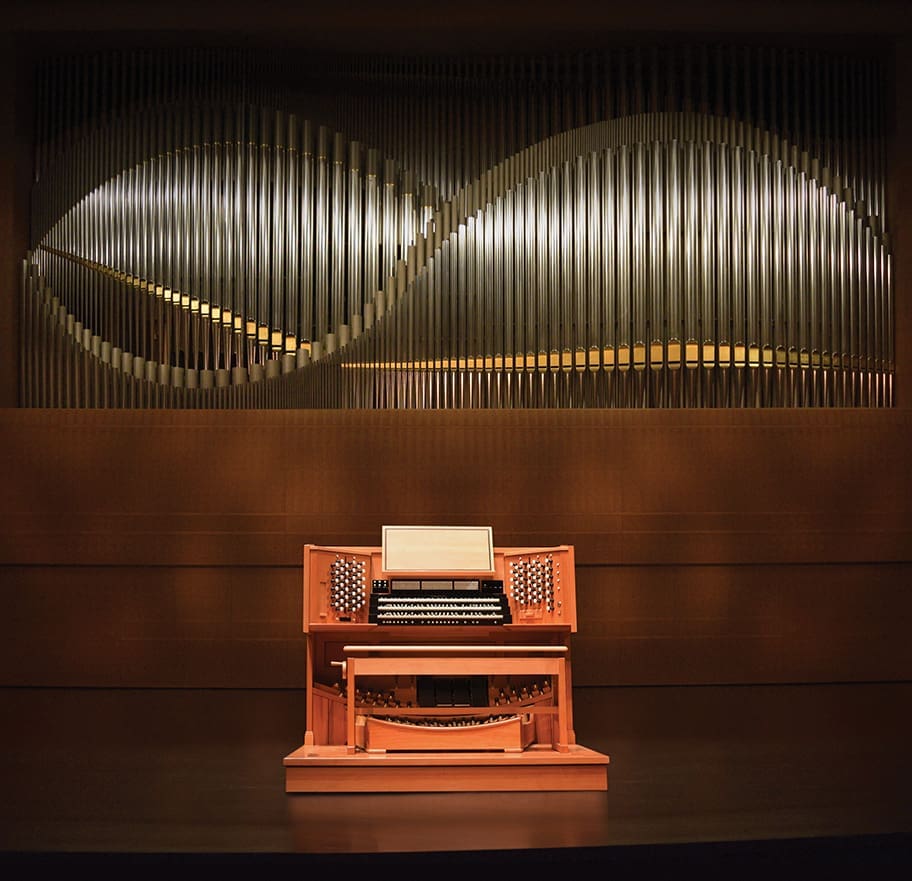
The Mighty
Klais
Overture Concert Organ
The Gift of Pleasant T. Rowland
Commissioned by the MSO in July 2001, the Overture Concert Organ was designed and built by the German firm of Orgelbau Klais. It consists of 63 stops, 72 ranks and 4,040 pipes, the tallest of which is 32 feet and the heaviest weighing in at more than 1,200 pounds. The organ took nearly three years to design and build. Including its unique movable chamber, the organ weighs in at 174 tons and is believed to be the heaviest movable object in any theater in the world.
Click here for full Organ Specifications
History
After a worldwide search that ended in July 2001, a team of MSO staff, board members and acousticians selected Orgelbau Klais in Bonn, Germany, to build the Overture Concert Organ.
The MSO’s Overture Concert Organ traveled from Germany and arrived in pieces on five semi-trucks in early March 2004. Installation of the 30-ton instrument’s 4,040 pipes was completed by the Klais artisans in August 2004.
Head Voicer for the Orgelbau Klais team, Markus Linden, worked for weeks on the meticulous process of “voicing” each of the 4,040 pipes. Voicing is a painstaking technical and artistic process that ensures every pipe “speaks” beautifully as a solo stop, and melds together with other pipes for a homogeneous sound. Final construction in Overture Hall had to cease during the tuning process, as reverberations or dust from construction were disruptive to the delicate process.
Design
“This organ will speak of Madison,” promised Philipp Klais, managing director of Orgelbau Klais. “It will reflect your history, your experiences, and even the way you speak. For us the most important aim is to reach the hearts of your audiences.”
One of the ways in which the organ “speaks” Madison is in its design. According to Overture Center architect Cesar Pelli, the organ façade reflects the soft curves of the Overture Hall ceiling and alludes to the natural reflections of the rolling hills surrounding Madison. Materials used include fir, oak, beech, plum and cedar, in addition to tin, lead, brass, steel, bone and ebony. The organ creates a landscape of shimmering and matte tin pipes within the frame of the warm glow of the wooden orchestra shell.
The organ and shell were designed to create a striking backdrop for the Madison Symphony Orchestra, and both elements are fully integrated into the acoustical environment in Overture Hall. The organ has architecturally integrated lighting to provide the opportunity for dramatic presentation of the instrument, depending on the piece being played. The console has three manuals (keyboards), each one with 61 keys, and the pedal board has 32 pedals (notes).
The movable organ chamber is designed with innovative engineering technology by Theatre Projects Consultants in partnership with the acoustical firm of Kirkegaard Associates. The instrument moves forward on 16 steel wheels on four steel rails, powered by a rigid push chain drive. No other organ in the world moves in this fashion. It takes about 30 minutes to roll the organ into place for Madison Symphony Orchestra concerts into either a “regular” or “choral” configuration. When not in use, the organ stores in a “garage” at the rear of the stage, with doors that hinge out from the main structure. In use or in storage, the organ and chamber are fully integrated into the acoustical environment of Overture Hall.
Donors
The Overture Concert Organ was made possible through an unprecedented $2.95 million in private contributions to the MSO: $1.1 million from Pleasant T. Rowland for the instrument; a $1 million endowment gift from Diane Endres Ballweg for organ programming and education; $500,000 from Elaine and Nicholas Mischler to endow the Organ Curatorship (a position currently held by MSO’s Principal Organist Greg Zelek); and gifts from The Malmquist Family and Margaret C. Winston.

